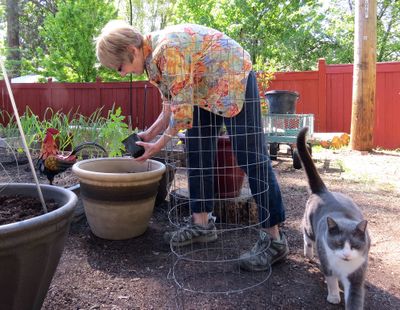In the Garden: Contain tomatoes, not excitement

It should come as no surprise that tomatoes are the most-planted crop in vegetable gardens. If you have a small garden, or perhaps no growing space at all, that doesn’t mean you have to miss out on this enjoyable pursuit. Why not grow them in containers instead?
Marilyn Lloyd has been growing tomatoes in containers for about a dozen years. A Master Gardener since 2008, she has limited areas in her garden that get the required six to eight hours of sunlight daily to grow these heat-loving plants.
“I also realize that as I get older, I might not be able to do as much so why not move the pots closer to the back door?” she said.
Lloyd likes how the soil in her containers stays loose and the fact that she has minimal weeding to do.
“I haven’t had problems with pests either,” she added. “But if I do, I can wrap the tomato cage with some screening to keep the pests out.”
This is feasible because tomatoes are self-pollinating. While it’s true that pollinator insects increase productivity by jostling the flowers, tomatoes have “perfect flowers” that contain both male and female organs.
Lloyd recommends starting with a pot that is 10 to 15 gallons in size.
“The bigger the better because they’ll stay moist longer and provide plenty of room for the roots,” she said.
Lloyd does not fill pots with garden soil as it can compress, making it difficult for water to pass through and for the roots to grow. She prefers using potting soil that contains fertilizer. When she uses an organic potting soil, she adds a 5-10-5 fertilizer. That middle number represents phosphorus, an important nutrient that helps plants bloom and set fruit.
One issue with growing in containers is that the soil can dry out quickly so it’s important to monitor the moisture frequently. To water her pots, Lloyd has a drip irrigation set-up that works well.
“The system has a line that goes from container to container, with one to two emitters per pot,” she said. “It’s on a timer and runs for about 20 minutes daily during the summer.”
Tomato plants require support so they won’t flop over as they grow, which has the potential for toppling the container as well. Lloyd uses cages made from welded wire that are anchored in the pots with metal pins.
“Don’t use the smaller tomato cages because they’re just not strong enough,” she advised. “I have small hands so I can reach in through the wire but sometimes the tomato I’m picking is too big to pull out. So I’d recommend using a welded wire with openings that are large enough.”
Another helpful recommendation is to place a weight such as a brick or rock in the bottom of the container to make it more stable. No matter what you use, be sure to leave room for drainage.
Lloyd prefers growing cherry tomatoes in her containers because the plants don’t get too heavy. She recommends choosing a determinate type, which has a bush form that tops out at about 4 feet. This type usually ripens all of its fruit at the same time. Determinate varieties include Patio Princess, Chocolate Cherry, Small Fry and Cherry Grande.
Her best success has been with a grafted Indigo Blue cherry tomato.
“It was the showiest plant I’ve ever had,” she said. “The problem is, nobody wants to eat a blue tomato!”